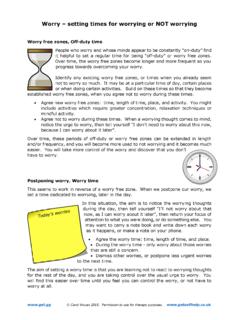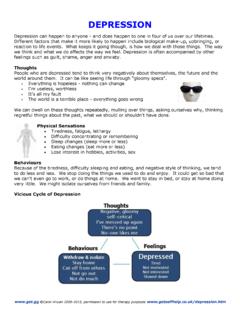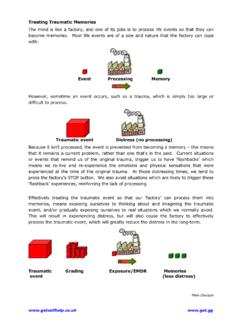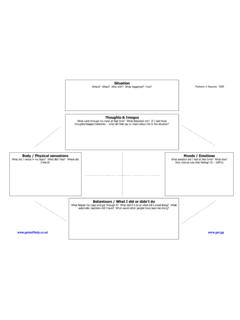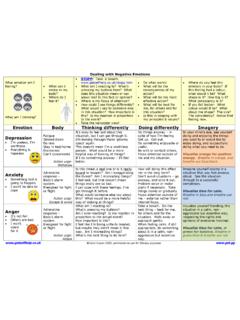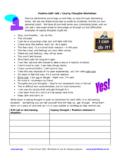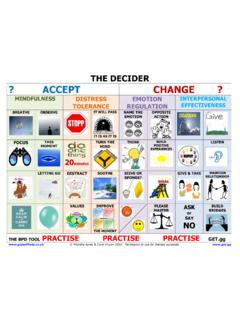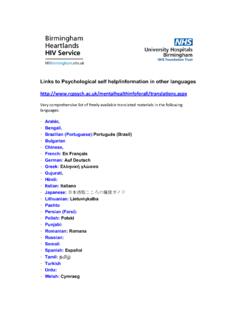Transcription of Manual of the Revised Cognitive Therapy Scale …
1 Manual of the Revised Cognitive Therapy Scale (CTS-R) James, Blackburn & Reichelt Collaborators A. Garland, P. Armstrong Dec. 2001 1 Manual of the Revised Cognitive Therapy Scale (CTS-R) Introduction This is a Scale for measuring therapist competence in Cognitive Therapy and is based on the original Cognitive Therapy Scales (CTS, Young & Beck, 1980, 1988). The CTS-R was developed jointly by clinicians and researchers at the Newcastle Cognitive and Behavioural Therapies Centre and the University of Newcastle upon Tyne, UK. The CTS-R contains 12 items, in contrast to earlier versions of the CTS which contained either 13 (Young & Beck, 1980) or 11 (Young & Beck, 1988).
2 The development of the Revised Scale , together with the psychometric properties, is described in the appendices. Table 1: The CTS-R Items General items Item 1: Agenda Setting & Adherence* Item 2: Feedback Item 3: Collaboration Item 4: Pacing and Efficient Use of Time Item 5: Interpersonal Effectiveness Cognitive Therapy specific items Item 1: Agenda Setting & Adherence* Item 6: Eliciting Appropriate Emotional Expression ** Item 7: Eliciting Key Cognitions Item 8: Eliciting Behaviours** Item 9: Guided Discovery Item 10: Conceptual Integration Item 11: Application of Change Methods Item 12: Homework Setting * Item 1 can be regarded as both a general and CT item.
3 ** Items 6 and 8 are new items developed for the Scale . Theoretical Bases of the Scale Two frameworks underpin the Revised Scale , the Cognitive Cycle and the Dreyfus Scale of Competence (Dreyfus, 1989). The Cognitive Cycle: The Cognitive cycle represented in Figure 1 demonstrates how the CTS-R items address specific Cognitive features. At the heart of the Scale , as in Therapy , is the conceptualisation. In order to move the patient from a dysfunctional cycle, dominated by a dysfunctional conceptualisation, the therapist must address the four features highlighted in the outer ring of the circle: thoughts, feelings, physiology and behaviour/planning.
4 In terms of therapeutic competence, the therapist's must be skilled at encouraging the patient to move around the points of the cycle, using the Cognitive Specific items (Items 6-12) to address the features. To facilitate the smooth movement around the cycle, the therapist must also demonstrate competence in areas assessed by the remaining items 1-5 (agenda & adherence, feedback, collaboration, pacing, interpersonal effectiveness). 2 Figure 1: The relationship between the CTS-R items and the Cognitive Cycle The cycle occurs within an Environmen the environment is explored mainly through Item 8 (Eliciting Behaviours) and Item 12 (Homework Setting).
5 Tal context. Its relevance toCOGNITIONSEMOTIONSBEHAVIOURAROUSALCONC EPTUALISATION Eliciting key cognitions Change methods Elicitingemotionalexpression Conceptualisation Guided discovery Elicitingbehaviours Change methods Homework Eliciting emotionalexpressionItems facilitating movement around circle Agenda Setting Feedback Collaboration Pacing & Efficient use of time Interpersonal Effectiveness Dreyfus Model of Competence: The Dreyfus Model has also been incorporated within the CTS-R. It is designed to assess the level of competence shown by the therapist (see Table 2). In the original Dreyfus Scale there are five levels, to this we added a further level to denote 'incompetence', as outlined below.
6 Table 2: Adapted Dreyfus Level of Competence Incompetent - The therapist commits errors and displays poor and unacceptable behaviour, leading to negative therapeutic consequences. Novice - At this level the therapist displays a rigid adherence to taught rules and is unable to take account of situational factors. He/she is not yet showing any discretionary judgement. Advanced Beginner - The therapist treats all aspects of the task separately and gives equal importance to them. There is evidence of situational perspective and discretionary judgement. Competent - The therapist is able to see the tasks linked within a conceptual framework. He/she makes plans within this framework and uses standardised and routinised procedures.
7 Proficient - The therapist sees the patient's problems holistically, prioritises tasks and is able to make quick decisions. The therapist is clearly skilled and able. Expert - The therapist no longer uses rules, guidelines or maxims. He/she has deep tacit understanding of the issues and is able to use novel problem-solving techniques. The skills are demonstrated even in the face of difficulties ( excessive avoidance). This model has been incorporated within the scoring system as demonstrated in the scoring layout below. 3 Scoring system A detailed explanation of the scoring system is provided below. As you can see, each item is rated on a Likert Scale , ranging from 0-6.
8 Each level being defined in detail to conform to the levels of competence (see Table 2). Example of the scoring layout: Key features: this is an operationalised description of the item (see examples within the CTS-R). Mark with an 'X' on the vertical line, using whole and half numbers, the level to which you think the therapist has fulfilled the key features. The descriptive features on the right are designed to guide your decision. Competence level Examples 0 Absence of feature, or highly inappropriate performance 1 Inappropriate performance, with major problems evident 2 Evidence of competence, but numerous problems and lack of consistency 3 Competent, but some problems and/or inconsistencies 4 Good features, but minor problems and/or inconsistencies 5 very good features, minimal problems and/or inconsistencies 6 excellent performance, or very good even in the face of patient difficulties {Incompeten{ {{{{Expert Proficient Competent Advanced beginner Novice t Please note that the top marks ( near the 'expert' end of the continuum)}}}}}}
9 Are reserved for those therapists demonstrating highly effective skills, particularly in the face of difficulties ( highly aggressive or avoidant patients; high levels of emotional discharge from the patients; and various situational factors). Maximum score on the Scale is 72 (12 x 6). At the Newcastle Cognitive Therapy Centre we set a minimum competence standard of 36, which would be an average of 3 marks per item. 4 Item 1 - Agenda Setting and Adherence Introduction The agenda helps ensure that the most important issues are addressed in an efficient manner. Therapist and patient must establish these issues jointly. The agenda should review items from the previous session(s), in particular the homework assignment, and include one or two items for the session.
10 Once set, it should be appropriately adhered to. However, if changes are necessary, because of an important new issue arising, the deviation from the agenda should be made explicit. The key features of the 'agenda' is outlined in the CTS-R Rating Scale as follows: Key features: To address adequately topics that have been agreed and set in an appropriate way. This involves the setting of discrete and realistic targets collaboratively. The format for setting the agenda may vary according to the stage of Therapy - see Manual . Three features need to be considered when scoring this item: (i) presence/absence of an agenda which is explicit, agreed and prioritised, and feasible in the time available; (ii) appropriateness of the contents of the agenda (to stage of Therapy , current concerns etc.)

